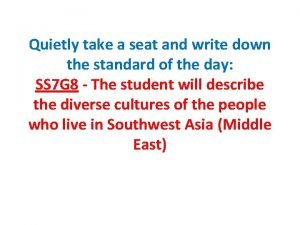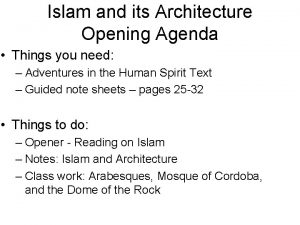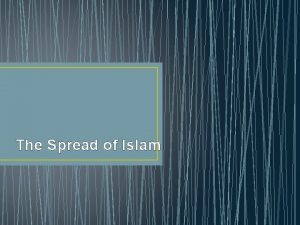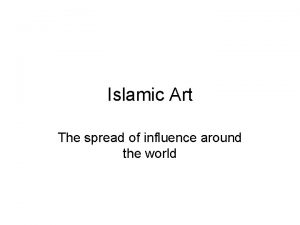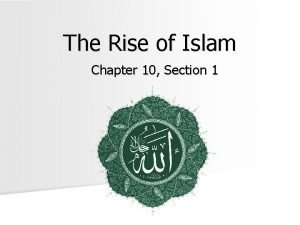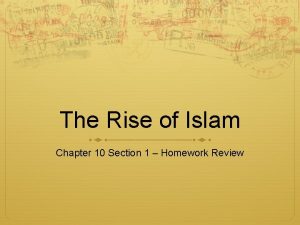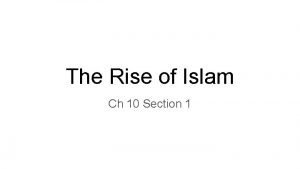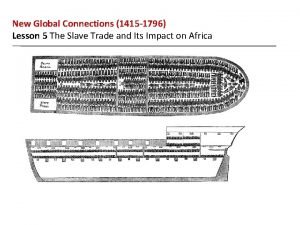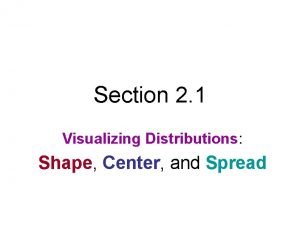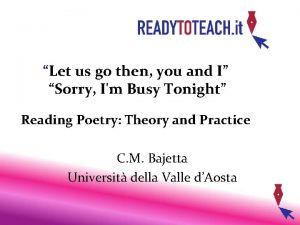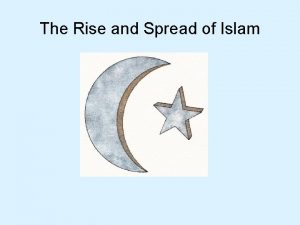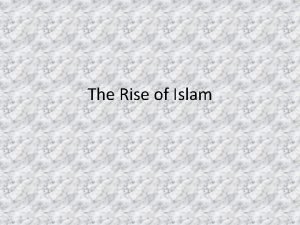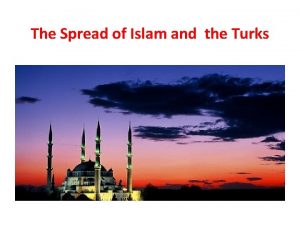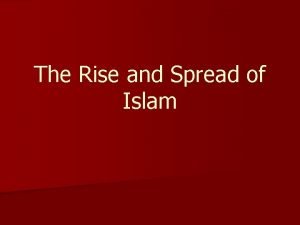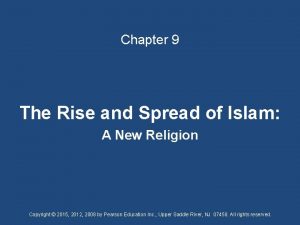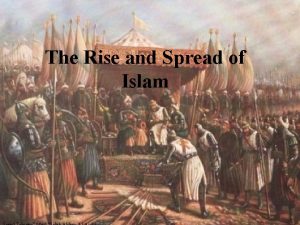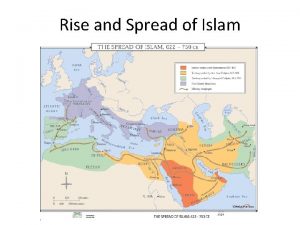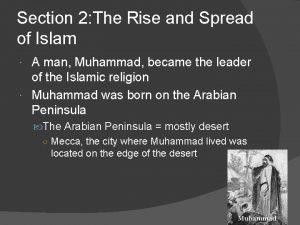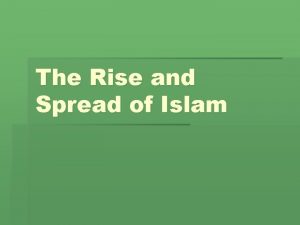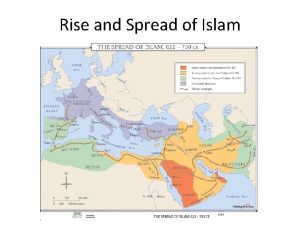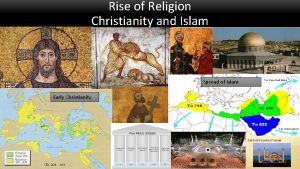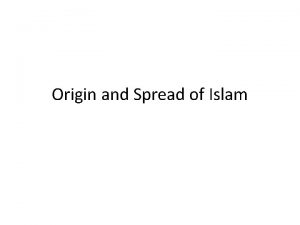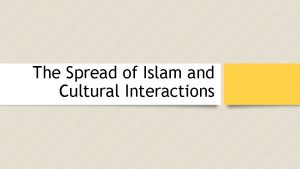Islam Its Rise Spread and Impact on the










































































- Slides: 74

Islam: Its Rise, Spread, and Impact on the World AP Exam Review

Part I: Rise of Islam through Fall of the Abbasid Caliphate AP Exam Review

The Pre-Islamic Arab World � Arab peninsula was a nomadic land on periphery of major civilizations – had contact but it was limited by geography � Bedouins – nomadic clans based on camel and goatherding who lived along caravan routes in mobile tent encampments � Towns grew up around oases & agricultural kingdoms in S. along Arabian sea (better farmland); most like Mecca/Medina founded by former Bedouins turned settled merchants � People linked by kinship, focus on clan and family, clan identities of great importance leading to rivalries � Kin-related clans group with others to make tribes which would only congregate for war or in a severe crisis


Bedouin Caravan Routes

Tribes


Bazaar

The Pre-Islamic Arab World Shaykhs – leaders of the tribe/clan who had large herds, several wives, many children/retainers � Town of Mecca dominates in south – controlled by Umayyad clan of Quraysh tribe � Has Ka’ba – important pre-Islamic religious shrine and the focus of bazaars � Medina – to the north – Unlike Mecca, run by five competing families – 2 Bedouin, 3 Jewish clans which would later help with formation of Islam � Pre-Islamic women had greater freedom; had important economic roles of milking camel, weaving cloth, raising children; not veiled/secluded like Persian neighbors; polygamy ok; lineage matrilineal; women in cities experience greater stratification � Bedouin religion – usually polytheistic/animistic but Quraysh believed one god was supreme - named Allah (but not prayed �

The Ka’ba at Mecca

Rise of Islam and the life of Muhammad � Muhammad born into prominent clan of Quraysh tribe c. 570 in Mecca, orphaned and raised by uncle and prominent grandfather (merchants) � Caravan trips exposed him to Christian/Jewish faiths, esp. in Jerusalem � Worked as a trader for Khadijah – later wife – and saw inequity of classes, class rivalries, tension between clans as some, Umayyads, got rich through commerce; Similar to Siddhartha Gautama (Buddha), Jesus � 610 – first revelation of many from angel Gabriel (Same as in Old Testament); wrote Allah’s words in Qur’an

Muhammad Receives the Message from Gabriel

Rise of Islam and the life of Muhammad Seen as threat to wealth/power by the Umayyad in Mecca b/c of growing following; threatened Ka’ba role which brought in money from visitors � Clansmen Ali sneaks him out to Medina in 622; ideal location b/c caught up in clan conflict and almost a civil war; Muh. invited to resolve disputes � Negations win him many converts (now called Muslims) � Quraysh send out attacks on Muh. but he proves himself a strong military leader leading to surrender of Umayyad/Quraysh 628 � 629 – 10 K converts enter city, destroy idols, Mecca inhabitants (including Umayyads/ Quraysh convert to Islam (can’t beat ‘em, so join ‘em) � Muh’s hadiths – traditions/actions – play a huge role in Islamic law, ritual � Muh. died 632 leading many to wonder if it would fall apart… �

Muhammad’s Entry into Mecca and Destruction of the Idols

Muhammad Resetting the Black Stone in the Ka’ba

“Ascent of the Prophet to Heaven” C. 1550

Islam’s Appeal and Theology � Islam belonged to no single tribe which offered an end to vendettas, feuds and united the Bedouin � Created an umma – community of the faithful – which transcended tribal boundaries � Grew quickly = in strength to other Semitic monotheistic faiths (Judaism, Christianity) � Allowed no intermediaries – priests, saints – so even more monotheistic than Christianity; gave Bedouins a single authority � Turned wars against selves into wars against others – conquered much of known world (Christians will do this later w/ Crusades)

Islam’s Appeal and Theology � Provided an ethical system to keep law and order w/ Shari’a law; life regulated to prepare for Judgment Day (like Christianity) � Seen by outside converts as a fulfillment to Judaism, Christianity � Universal Elements in Islam – called Five Pillars � 1. Confession of Faith: “There is no God but Allah, and Muh. is his prophet” – no other gods � 2. Pray five times a day facing Mecca � 3. Fast sunup to sundown during Ramadan – holy month � 4. Zakat (charity tax) for those in need � 5. Hajj - pilgrimage to Ka’ba to worship Allah

Islam’s Early Years and Conquest � After Muh’s death, some renounced faith, argued over succession � However, others lead foreign expeditions, easily beat neighbors due to military prowess, religious zeal, border empire weakness � New lands/people ruled by small Arab warrior elite � Muh. gave no procedure for appointing successor but eventually, leader known as caliph (dynasties were caliphates) � Ali – cousin/son-in-law said to be too young so Abu Bakr – earliest follower, closest friend named caliph (632 -634)

Ali (Ali ibn Abi Talib) 600 -661 CE

Abu Bakr 1 st Caliph c. 573 – c. 634 CE

Islam’s Early Years and Conquest � Ridda Wars – successfully fought to defeat Bedouin tribes who refused to embrace Islam; success made Abu Bakr push north into Fertile Crescent, Byzantine & Persian empires � Initially just raided for spoils but raids showed weakness of empires; also many residents annoyed w/ Byz. /Persial leaders so helped Muslims � Not driven by desire to win converts – even avoided mass conversions b/c wanted tax money (jizya) for non-Muslims (can’t tax Muslims) � Early wars not jihads - holy wars to spread Muslim faith

Ridda Wars

Neighboring Empires

The Sunni-Shi’a Split �Old clan rivalries still under the surface �Spark: murder of third caliph Uthman in 656 (2 nd was Umar who ruled fairly peacefully) – Abu Bakr, Umar, Uthman called early caliphs �Ali (son-in-law/cousin) regains throne and doesn’t punish assassins of Uthman, an Umayyad – now the war is on w/ Umayyads �Ali’s forces were winning, but he decides on mediation at Battle of Siffin which makes him look weak and leads to Mu’awiya in 660 (Umayyad) claim he is new caliph from Jerusalem

Imams Umayyads Abbasids

Umar 2 nd Caliph c. 584 -644 AD

Uthman 3 rd Caliph c. 579 -656 AD

Battle of Siffin 657 AD

Muawiyah I – 1 st of the Umayyad Caliphate 602 -680 AD

The Sunni-Shi’a Split �Ali assassinated; 1 st son has to renounce claim to throne, 2 nd son killed (Husayn) �And now we have a feud �Backers of Umayyads/Caliphs in Power (Sunni) vs. backers of Ali (Shi’a) �Sunni Caliph goes through dominant clan vs. Shi’a caliph goes through descendants of Muhammad (called imams)

Ali (Ali ibn Abi Talib) 600 -661 CE

Hussayn, son of Ali Grandson of Muhammad 625 -669 AD

Expansion, Decline and Fall of the Umayyad Caliphate � Umayyad Caliphs begin building an east/west empire; runs into conflict w/ Buddhism in east after spreads across India & goes into Spain in West but eventually stopped by Charles Martel (Franks) at Poitiers 732 � By late 700 s empire stretches from Spain to steppes and Indus River valley; capital moved from Mecca to Damascus, Syria – Arab/Muslim aristocracy ruled over non-Arabs/Muslims � Non-Muslims do convert but considered Mawali, still taxed � Jews, Christians (later Hindus, Buddhists) were considered Dhimmi (People of the Book) allowed to continue to worship given religions so there weren’t many conversions under Umayyads

Expansion of Islam to 750 C. E.

Expansion, Decline and Fall of the Umayyad Caliphate Umayyad caliph’s had a growing addiction to luxury and soft living by mid 700 s; stopped fighting wars, built palaces � Revolts start around empire at their signs of weakness � The Abbasid Revolt is their undoing � Abbasids (descendants of Muh’s uncle) formed a coalition: 50 K Muslim warriors in Merv (part of Persia, rarely given share of spoils so annoyed at distant Umayyad elite) + mawali (annoyed at taxes) + Shi’a � Coalition defeated Umayyad caliph at Battle on the River Zab � Invited the rest of the Umayyad family to a fake peace-making dinner but wrapped them in carpets and slaughtered them; hunted down the rest � One guy made it out – established Caliphate of Cordoba where he and his successors lived in exile in Spain until 1400 s kicked out �

Charles Martel and the Battle of Poitiers, 732

Merv

The Abbasid Caliphate � Abbasids less tolerant of Shi’a sects (they were Sunnis) � Shi’a and mawali supporters of Abbasids should have seen it coming (feast murders and all…) � Pushed for centralized, absolutist imperial order; moved capital to Baghdad; had jeweled thrones � Expanded number of bureaucrats – sound like China? Appointed a wazir – chief administrator to help run empire � Under Abbasids, mawali given equal footing to Arab Muslims so no longer have to pay head tax (jizya) for being non-Muslim

Abbasid Caliphate at its Greatest Extent

Trade under the Abbasids BTW: all of this while Eur. struggling after fall of W. Roman empire � Merchant class wealth and social status improves, trade becomes a priority under Abbasids � Afro-Eurasian trading resumes after Rome/ Han China let it die (b/c they die!) � But now, mostly through Asian Sea Trade Used � Dhows – Arab ships w/ lateen (triangular) sails used monsoon winds � Products – luxury products for elites � Money reinvested in companies, share given to charity � Also used in patronage of the arts, beautification, infrastructure � Built beautiful mosques, religious schools, baths, hospitals, rest houses w/ trade $ to facilitate movement across empire � Exports: furniture, glassware, jewelry, tapestries/carpets � Landed elite emerges – ayan � Traded goods but also ideas �

Arab Dhow with Lateen Sails


Arts, Culture, and Science in the Abbasid Era Political divisions did not hold Abbasids & rest of Muslim world back artistically/technologically; one of great ages in human ingenuity and creativity � Preserved classical texts of Greece, Mediterranean, Middle East, India; without Muslim and Jewish scholars much of classical knowledge would be lost � Architecture – the mosque; borrowed from classical architecture, sometimes even used materials from destroyed churches/temples � • Had repeating geometric designs, arabesque, and Arabic calligraphy � Expansion of professional classes under Abbasids – doctors, scholars, legal/religious experts; also artisans (made rugs, furniture, textiles, pottery etc.

Arts, Culture, and Science in the Abbasid Era � When Abbasids moved capital to Baghdad, came under major Persian influence • Persian language = high culture; used in literature, poetry, rhetoric • Epic Poem – Shah-Nama (Book of Kings)– written in 10 th/11 th centuries � Sciences: Arabic remained the language of science, law, established religion • Math – Made corrections to Greek algebra, geometry, trigonometry • Used objective experimentation, created classification system of animal, vegetable, mineral; best astronomy in the world • Health/Medicine: best hospitals – doctors were required to pass formal examinations, optics/bladder ailments were a specialty • Other inventions: trade w/China led to papermaking, silk-weaving, ceramics • Cartography: best maps in the world

The Mosque




Calligraphy

Arabesque and Minaret

More Arabesque

Pages from the Shah-Nama


Muslim Science

Impact of the Crusades � First Crusade 1096 -1099 – most successful for Europeans �element of surprise, took advantage of Muslim political divisions �Europeans killed Muslim and Jewish inhabitants of Jerusalem � Followed by 200 years of battle – but had little effect on Muslim world � Saladin – Salah-ud-Din – reconquered most of lost territory by end of 12 th century after uniting Muslims under a strong leader � Impact much greater on Christian Europe


Impact of the Crusades � Examples of European cultural borrowing �weapons – damascene sword (from Damascus) & fortifications �science/medicine – many Europeans preferred Muslim doctors �recovered Greek learning – brought it back to Europe, eventually leads to Renaissance �mastered Arabic (former Indian) numerals �Middle Eastern rugs/textiles popular; new names for cloths – taffeta, muslin develop �Games & Music: Chess (also originally Indian), troubadours/ballads �Food – dates, coffee, yogurt

Class, Gender, and Religion in the Abbasid Era Women in decline in Abb. Era although Islam had been egalitarian at start • Harems develop – women kept in seclusion – was a creation of Abbasid court, much due to Persian influence • Slave women could win their freedom/gain power by bearing healthy sons; could be educated & had more freedom w/ no veils, robes, seclusion � Religious scholars called ulama develop and embrace orthodoxy � Orthodox Muslims gained power after Crusades (b/c Western learning ) �Ulama suspicious of Greek learning b/c based on questioning �threatened ulama’s authority and people’s devotion to Qur’an �said Qur’an was final, perfect, a complete revelation �

Class, Gender, and Religion in the Abbasid Era � Al-Ghazali tried to fuse Greek/Arab traditions; greatest Islamic theologian �Ideas usually rejected by orthodox Muslims � Sufis/Sufist movement – more mystical; reaction to orthodoxy �Wanted a personal union with Allah �Became wandering mystical healers; some led militant bands to forcibly convert �some used bodily denial, asceticism to find Allah in their lives �some used meditation, songs, drugs, dancing (whirling dervishes) �helped expand religion by whirling their way all the way to SE Asia!

Ulama Instructing Religious Learners

Al-Ghazali 1058 -1111

Modern Sufis

Whirling Dervish

Abbasid Decline and Fall � 3 rd Abbasid caliph, al-Mahdi – displayed common problems (Ibn Khaldun article); financial drain w/ courtly excesses, luxury, monumental buildings � Problem of succession: al-Mahdi wouldn’t name a successor; son Harun al-Rashid (786 -809) poisoned him, became most influential Abbasid ruler � Rashid’s Caliphate – Extravagance amazed visitors like Charlemagne • The Thousand One Nights describe this well • Persian advisors grew in power which signaled shift – court advisors now more important than caliphs sometimes • His death led to civil war; winner had huge army & started precedent of having mercenary forces could reach 70 K; power now shifted to military

Abbasid Decline and Fall Caliphs try to move capitals away from Baghdad – kind of like Versailles �Cost of new palaces/capitals plus mercenary force = high taxes �Peasant revolts due to taxation, Shi’a “encouragement” � Nomadic invasions begin as they realized Abb. Empire’s internal weakness • 945 Buyids invade, capture Baghdad; took name of sultan – “victorious” & controlled Abbasid caliphs as puppets • 1055 Seljuk Turks (Sunnis) replaced Buyids, purged Shi’a • Mongols under Chinggis’s grandson Hulegu overthrows Baghdad in 1258 & last (27 th ) Abb. Caliph • Cairo and Istanbul became dominant Muslim cities instead �

Coins from Abbasid Ruler al-Mahdi’s Caliphate

Abbasid Court Life


Huran al-Rashid Abbasid Caliph 786 -809

Huran al-Rashid receiving a delegation of Charlemagne


Chinggis Khan r. 1206– 1227

Hulegu Khan
 Richard nixon tricky dicky
Richard nixon tricky dicky Rise and rise again
Rise and rise again Raise and rise again until lambs become lions
Raise and rise again until lambs become lions Rise and rise again until lambs become lions origin
Rise and rise again until lambs become lions origin How does document e explain how islam spread so quickly
How does document e explain how islam spread so quickly Spread of islam through architecture exit slip
Spread of islam through architecture exit slip Spread betting islam
Spread betting islam Spread betting islam
Spread betting islam Spread betting islam
Spread betting islam Qiyamm
Qiyamm The rise of islam worksheet answers chapter 10 section 1
The rise of islam worksheet answers chapter 10 section 1 How did the rise of islam change the lives of women?
How did the rise of islam change the lives of women? Rise of islam timeline
Rise of islam timeline The rise of islam chapter 10 section 1
The rise of islam chapter 10 section 1 Characteristics of renaissance
Characteristics of renaissance Lesson 5 the slave trade and its impact on africa
Lesson 5 the slave trade and its impact on africa Hak asasi manusia tasawwur islam
Hak asasi manusia tasawwur islam Cara mencapai matlamat perundangan islam
Cara mencapai matlamat perundangan islam Latar belakang kerajaan abbasiyah
Latar belakang kerajaan abbasiyah Bright filled paperweight
Bright filled paperweight Its halloween its halloween the moon is full and bright
Its halloween its halloween the moon is full and bright When a train increases its velocity its momentum
When a train increases its velocity its momentum Cloudy windy rainy sunny
Cloudy windy rainy sunny If its square its a sonnet summary
If its square its a sonnet summary Its not easy but its worth it
Its not easy but its worth it Hình ảnh bộ gõ cơ thể búng tay
Hình ảnh bộ gõ cơ thể búng tay Bổ thể
Bổ thể Tỉ lệ cơ thể trẻ em
Tỉ lệ cơ thể trẻ em Chó sói
Chó sói Thang điểm glasgow
Thang điểm glasgow Hát lên người ơi alleluia
Hát lên người ơi alleluia Kể tên các môn thể thao
Kể tên các môn thể thao Thế nào là hệ số cao nhất
Thế nào là hệ số cao nhất Các châu lục và đại dương trên thế giới
Các châu lục và đại dương trên thế giới Công của trọng lực
Công của trọng lực Trời xanh đây là của chúng ta thể thơ
Trời xanh đây là của chúng ta thể thơ Mật thư tọa độ 5x5
Mật thư tọa độ 5x5 Làm thế nào để 102-1=99
Làm thế nào để 102-1=99 độ dài liên kết
độ dài liên kết Các châu lục và đại dương trên thế giới
Các châu lục và đại dương trên thế giới Thể thơ truyền thống
Thể thơ truyền thống Quá trình desamine hóa có thể tạo ra
Quá trình desamine hóa có thể tạo ra Một số thể thơ truyền thống
Một số thể thơ truyền thống Cái miệng nó xinh thế chỉ nói điều hay thôi
Cái miệng nó xinh thế chỉ nói điều hay thôi Vẽ hình chiếu vuông góc của vật thể sau
Vẽ hình chiếu vuông góc của vật thể sau Nguyên nhân của sự mỏi cơ sinh 8
Nguyên nhân của sự mỏi cơ sinh 8 đặc điểm cơ thể của người tối cổ
đặc điểm cơ thể của người tối cổ Ví dụ giọng cùng tên
Ví dụ giọng cùng tên Vẽ hình chiếu đứng bằng cạnh của vật thể
Vẽ hình chiếu đứng bằng cạnh của vật thể Fecboak
Fecboak Thẻ vin
Thẻ vin đại từ thay thế
đại từ thay thế điện thế nghỉ
điện thế nghỉ Tư thế ngồi viết
Tư thế ngồi viết Diễn thế sinh thái là
Diễn thế sinh thái là Các loại đột biến cấu trúc nhiễm sắc thể
Các loại đột biến cấu trúc nhiễm sắc thể So nguyen to
So nguyen to Tư thế ngồi viết
Tư thế ngồi viết Lời thề hippocrates
Lời thề hippocrates Thiếu nhi thế giới liên hoan
Thiếu nhi thế giới liên hoan ưu thế lai là gì
ưu thế lai là gì Sự nuôi và dạy con của hươu
Sự nuôi và dạy con của hươu Khi nào hổ mẹ dạy hổ con săn mồi
Khi nào hổ mẹ dạy hổ con săn mồi Sơ đồ cơ thể người
Sơ đồ cơ thể người Từ ngữ thể hiện lòng nhân hậu
Từ ngữ thể hiện lòng nhân hậu Thế nào là mạng điện lắp đặt kiểu nổi
Thế nào là mạng điện lắp đặt kiểu nổi What sandwich component is made up of bread?
What sandwich component is made up of bread? Pour plate method steps
Pour plate method steps Shape of dot plot
Shape of dot plot Central tendency and spread homework
Central tendency and spread homework Let us go then you and i ts eliot
Let us go then you and i ts eliot Measure of center
Measure of center Comparing data displays
Comparing data displays Where did christianity originate
Where did christianity originate




